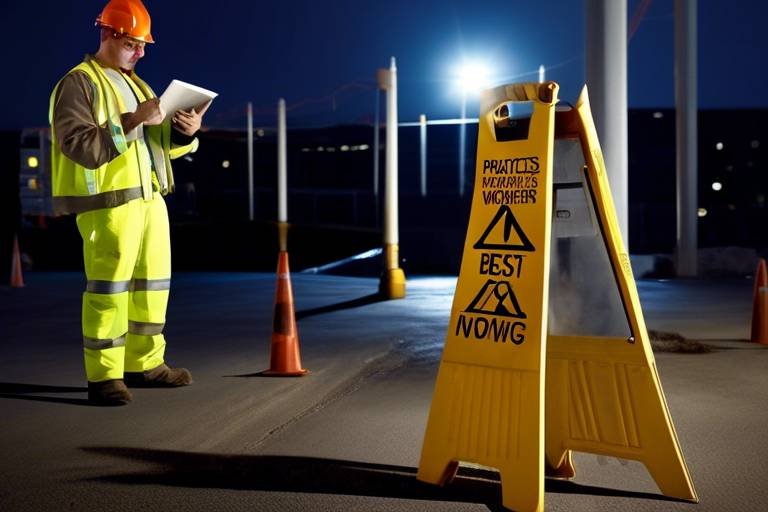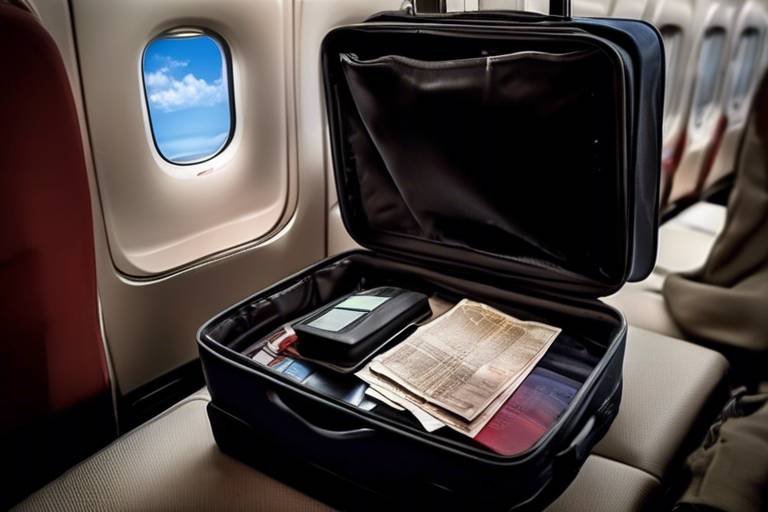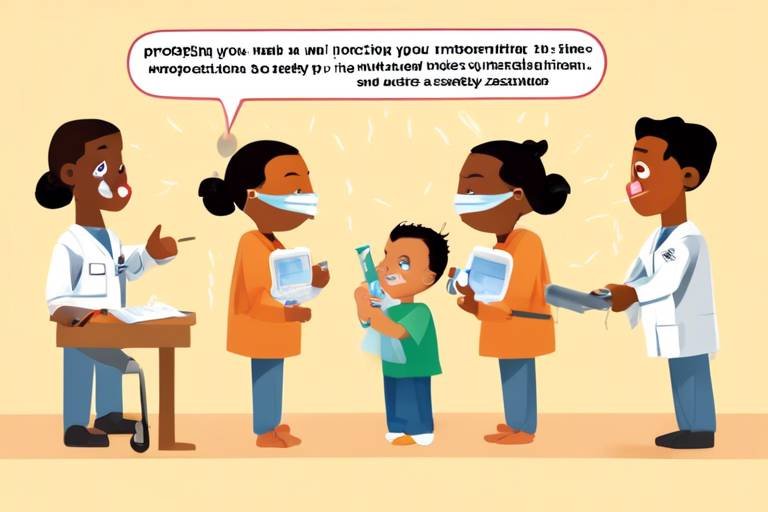Ensuring Safety in a Shared Working Space
In today's dynamic work environment, shared working spaces have become increasingly popular. They offer flexibility, collaboration, and a sense of community among employees. However, with these benefits come certain challenges, particularly regarding safety. Ensuring safety in a shared working space is not just a responsibility; it's a necessity that requires the collective effort of everyone involved. Just like a well-oiled machine, each part must function correctly to avoid breakdowns, and in the context of safety, this means identifying risks, establishing protocols, and fostering a culture of communication.
Imagine walking into an office where everyone is aware of their surroundings, where potential hazards are identified before they can cause harm, and where each individual takes ownership of their safety as well as that of their colleagues. This vision can be realized through a combination of proactive measures, continuous education, and open dialogue. In the following sections, we will delve into the essential strategies that can help maintain a secure environment in shared workspaces. From recognizing potential hazards to establishing robust safety protocols, every step we take is crucial in creating a safe haven for collaboration and productivity.
So, how do we begin this important journey? The first step is to identify potential hazards that may lurk in common areas. Whether it’s a cluttered workspace, faulty electrical equipment, or inadequate emergency exits, recognizing these risks is vital. Once identified, we can move forward with establishing safety protocols that clearly outline the responsibilities of each individual. This is where training and education play a pivotal role, ensuring that everyone is equipped with the knowledge they need to navigate their work environment safely.
Moreover, fostering a culture of open communication cannot be overstated. When employees feel comfortable voicing their concerns, it leads to proactive safety measures and enhances overall morale. Safety is a shared responsibility, and when everyone is engaged, the workplace becomes a safer place to thrive. Let’s explore these strategies in detail to ensure that safety in our shared working space is not just a goal but a reality.
Recognizing potential hazards is the first step in ensuring safety. This section discusses common risks found in shared workspaces and how to effectively identify them before they lead to accidents.
Implementing clear safety protocols is crucial for any shared workspace. This part outlines the necessary guidelines and procedures to ensure everyone understands their roles in maintaining a safe environment.
Regular training sessions are vital for keeping safety protocols fresh in everyone's mind. This section emphasizes the importance of ongoing education and how it contributes to a culture of safety.
A well-defined emergency response plan is essential for effective crisis management. This subsection discusses how to create and communicate these plans to all employees.
Providing first aid training equips employees with the skills to respond to medical emergencies. This part highlights the benefits of having trained personnel in the workplace.
Open communication fosters a safe working environment. This section explores how encouraging employees to voice concerns can lead to proactive safety measures and improved morale.
Conducting regular safety audits helps identify areas for improvement. This section explains the process of auditing and how it contributes to maintaining a high standard of safety in shared spaces.
Implementing feedback mechanisms allows employees to report safety issues anonymously. This subsection discusses various methods for gathering feedback and their importance in enhancing workplace safety.
Safety measures should evolve with the workplace. This section emphasizes the necessity of continuously reviewing and updating safety protocols to adapt to changing conditions and new challenges.
Q: What are some common hazards in shared workspaces?
A: Common hazards include cluttered walkways, electrical hazards, and inadequate emergency exits.
Q: How can we promote a culture of safety?
A: By encouraging open communication, providing regular training, and involving everyone in safety discussions.
Q: What should be included in an emergency response plan?
A: An emergency response plan should include evacuation procedures, contact information for emergency services, and designated roles for employees during a crisis.

Identifying Potential Hazards
When we think about safety in shared working spaces, the first step is often the most crucial: . Imagine walking into an office filled with people, buzzing with energy, but lurking in the background are risks that could lead to accidents if not addressed. Recognizing these risks is like shining a flashlight into a dark room; it illuminates the dangers that could otherwise go unnoticed. Common hazards in shared workspaces can range from physical dangers, such as trip hazards, to ergonomic issues that can lead to long-term health problems.
One of the most prevalent risks in shared environments is clutter. It’s easy for a workspace to become messy, especially when multiple people are using the same area. Items left on the floor or desks can create trip hazards that lead to falls, which are among the most common workplace injuries. Moreover, clutter can impede emergency exits, making it difficult for employees to evacuate in case of an emergency. Conducting regular checks to ensure that walkways and work areas are clear is essential.
Another significant hazard is the improper use of equipment. In a shared workspace, various tools and machines are often used by different individuals. Without proper training or clear instructions, employees may misuse equipment, leading to accidents. For instance, if someone is unfamiliar with a printer or copier, they might attempt to fix a jam without knowing how to do so safely. This not only poses a risk to the individual but also to others around them.
To effectively identify potential hazards, it’s important to involve everyone in the process. Encourage employees to speak up about their concerns. After all, they are the ones interacting with the workspace daily and can often spot issues that management might overlook. Implementing regular safety walkthroughs can also be beneficial. During these walkthroughs, teams can collectively assess the workspace for any potential risks. Here’s a simple table that outlines some common hazards and how to identify them:
| Hazard Type | Examples | Identification Method |
|---|---|---|
| Physical Hazards | Clutter, wet floors | Regular inspections, employee feedback |
| Ergonomic Hazards | Poor workstation setup | Employee surveys, ergonomic assessments |
| Equipment Hazards | Improperly used tools | Training sessions, observation |
In conclusion, identifying potential hazards in a shared workspace is not just about spotting dangers; it's about creating a culture of safety where everyone feels responsible for the well-being of their colleagues. By encouraging open communication and regular assessments, organizations can not only protect their employees but also foster a more productive and harmonious working environment.

Establishing Safety Protocols
Implementing clear safety protocols is crucial for any shared workspace. Think of safety protocols as the backbone of a healthy work environment; without them, everything can crumble like a house of cards. These protocols not only define the rules but also create a culture of accountability and awareness. When everyone knows what is expected of them, it leads to a more secure atmosphere for all. So, what does establishing these protocols entail? Let's break it down.
First and foremost, it's essential to have a comprehensive understanding of the workspace and the specific risks associated with it. For instance, in a shared office, you might encounter hazards like exposed electrical wires, cluttered walkways, or even improper use of office equipment. By identifying these risks, you can tailor your safety protocols to address them directly. A thorough risk assessment can be a game-changer here, serving as the foundation upon which all safety measures are built.
Next, everyone involved must be on the same page. This involves drafting a clear set of guidelines that outline the safety protocols. These guidelines should cover various aspects, such as:
- Emergency procedures, including evacuation routes and assembly points.
- Proper use of equipment and tools.
- Reporting procedures for unsafe conditions or incidents.
- Personal protective equipment (PPE) requirements, if necessary.
Once you have these guidelines in place, the next step is to communicate them effectively. Think of it as teaching a new language; if you don't practice it, you'll forget it. Hold meetings, send out emails, and even create visual aids like posters to ensure that everyone is aware of the protocols. Regular reminders can help keep these safety measures fresh in everyone’s mind.
Moreover, establishing a system for accountability is vital. Assign specific roles and responsibilities related to safety. For example, you might designate a safety officer or a safety committee responsible for monitoring compliance with the protocols. This not only ensures that someone is always vigilant but also empowers individuals to take ownership of their safety and the safety of their colleagues.
To make the protocols even more effective, consider incorporating technology. There are numerous apps and software available that can help monitor safety compliance, track incidents, and even facilitate training sessions. Embracing technology not only streamlines the process but also makes it easier for everyone to stay informed and engaged.
Finally, remember that safety protocols are not set in stone. They should evolve as the workspace changes. Regularly reviewing and updating these protocols ensures they remain relevant and effective. Encourage feedback from employees; they are often the first to notice what works and what doesn’t. By creating an environment where safety is a shared responsibility, you foster a culture that prioritizes the well-being of everyone involved.
Q: What should I do if I notice a safety hazard?
A: Report it immediately to your safety officer or supervisor. It's crucial to address hazards before they lead to accidents.
Q: How often should safety protocols be reviewed?
A: Ideally, safety protocols should be reviewed at least once a year or whenever there are significant changes in the workspace.
Q: What if I don’t feel comfortable reporting a safety issue?
A: Many organizations offer anonymous reporting mechanisms. Utilize these options if you feel hesitant to speak up directly.
Q: Are safety training sessions mandatory?
A: Yes, regular training sessions are essential to keep everyone updated on safety protocols and procedures.

Training and Education
When it comes to ensuring safety in a shared working space, play a pivotal role. Think of it as the bedrock of a solid safety culture—without it, everything else can come tumbling down like a house of cards. Regular training sessions not only refresh everyone's knowledge of safety protocols but also serve as a reminder that safety is a shared responsibility. After all, would you trust someone to drive a car without proper training? The same principle applies to workplace safety.
In an environment where multiple individuals work closely together, the potential for accidents increases. This is why ongoing education about safety measures is crucial. Training should cover a variety of topics, including but not limited to:
- Recognizing potential hazards
- Proper use of equipment
- Emergency response procedures
- First aid skills
Imagine walking into a workplace where everyone is equipped with the knowledge to handle emergencies effectively. It’s not just about knowing how to react; it’s about creating a culture where safety is prioritized and everyone feels empowered to contribute. Regular workshops, seminars, and even online courses can keep safety at the forefront of employees' minds, ensuring they are always prepared.
Moreover, training should not be a one-time event but rather a continuous process. As new employees join or as protocols change, it’s essential to update training materials and sessions. This not only keeps everyone informed but also fosters a sense of community and teamwork, as employees learn together and share their insights and experiences.
To track the effectiveness of training programs, organizations can implement assessments and feedback mechanisms. This could look like a simple quiz after a training session or an anonymous survey asking for suggestions on how to improve safety practices. By actively seeking feedback, companies can adapt their training programs to better meet the needs of their employees, ensuring that everyone is on the same page when it comes to safety.
In conclusion, investing in is not just a checkbox on a compliance list; it’s a vital component of a safe working environment. When employees are educated about safety practices, they are more likely to take ownership of their actions, leading to a more secure and collaborative workspace. So, let’s make safety training a priority and watch as the entire workplace becomes a safer place for everyone.

Emergency Response Plans
In any shared workspace, having a well-defined emergency response plan is not just a good idea; it's a necessity. Imagine being caught in a crisis without knowing what to do—it's like being lost in a maze with no exit in sight. An effective emergency response plan acts as your roadmap, guiding everyone through the chaos. It ensures that all employees are prepared to react swiftly and safely, minimizing panic and confusion when every second counts.
To create a robust emergency response plan, start by identifying the specific types of emergencies that could occur in your workspace. These might include fire evacuations, medical emergencies, natural disasters, or even security threats. Once you've pinpointed potential crises, outline clear procedures for each scenario. For instance, if a fire alarm sounds, everyone should know the quickest exits and the designated meeting point outside the building. This is where communication becomes key—make sure that every employee is aware of these procedures and understands their roles during an emergency.
Next, regular drills are essential for ensuring that everyone knows how to act in case of an emergency. Think of these drills as practice runs for a performance; just like actors rehearse their lines, employees need to rehearse their emergency responses. By conducting these drills periodically, you reinforce the procedures in everyone's minds, making it second nature to follow them when it really matters.
Another crucial aspect of your emergency response plan is ensuring that it is easily accessible. Consider creating a visual guide or a quick-reference poster that outlines the steps to take in various emergencies. Display these materials prominently around the workspace, so they are always within reach. Additionally, digital copies can be shared via email or on your company’s intranet, ensuring that everyone can access them anytime.
Lastly, it’s vital to review and update your emergency response plan regularly. As your workplace evolves—whether through changes in personnel, layout, or even the nature of the work itself—so too should your response strategies. Schedule annual reviews to assess the effectiveness of your plan and make necessary adjustments. This proactive approach not only enhances safety but also fosters a culture of preparedness among employees.
In summary, a well-crafted emergency response plan is a cornerstone of safety in shared workspaces. By preparing for the unexpected, you empower your team to act decisively and confidently, turning potential chaos into coordinated action. Remember, safety is not just about compliance; it’s about creating an environment where everyone feels secure and supported.
- What should be included in an emergency response plan? An emergency response plan should include procedures for various emergencies, evacuation routes, designated meeting points, and roles for employees during a crisis.
- How often should emergency drills be conducted? Emergency drills should be conducted at least twice a year to ensure that employees are familiar with the procedures and can respond effectively.
- Who is responsible for creating the emergency response plan? Typically, a safety officer or a designated team should be responsible for creating and updating the emergency response plan, but input from all employees is valuable.

First Aid Training
First aid training is not just a nice-to-have; it’s a critical component of workplace safety that can mean the difference between life and death. Imagine a scenario where an employee suddenly collapses due to a medical emergency. Would your team know what to do? This is where first aid training steps in, equipping your workforce with the necessary skills to respond effectively in emergencies. Not only does it empower employees to act swiftly, but it also fosters a culture of safety where everyone feels responsible for one another's well-being.
Providing first aid training comes with numerous benefits. For starters, it enhances the overall safety of the workplace. When employees are trained to handle emergencies, they can mitigate risks and potentially save lives. Furthermore, it can significantly reduce the severity of injuries, ensuring that individuals receive immediate care before professional medical help arrives. This is particularly important in shared working environments where the potential for accidents is higher due to the close proximity of individuals and shared equipment.
Moreover, first aid training promotes team cohesion. When employees participate in training sessions together, they build trust and camaraderie. They learn to rely on one another in times of crisis, creating a more supportive workplace culture. Employees who feel connected to their colleagues are likely to be more engaged and productive. In essence, first aid training not only prepares your team for emergencies but also strengthens workplace relationships.
To implement an effective first aid training program, consider the following key elements:
- Qualified Instructors: Ensure that the training is conducted by certified professionals who have extensive knowledge and experience in first aid.
- Hands-On Practice: Incorporate practical exercises that allow employees to practice their skills in realistic scenarios.
- Regular Refreshers: Schedule periodic refresher courses to keep skills sharp and knowledge up-to-date.
- Certification: Provide participants with official certification upon completion of the training, which can boost their confidence and commitment to workplace safety.
In conclusion, investing in first aid training is a proactive step toward ensuring a safe working environment. Not only does it prepare employees to handle emergencies effectively, but it also cultivates a culture of safety and teamwork. By prioritizing first aid training, you are not just complying with regulations; you are demonstrating a genuine commitment to the health and safety of your workforce.
Q: How often should first aid training be conducted?
A: It is recommended to conduct first aid training at least once a year, with refresher courses every six months to ensure skills remain sharp.
Q: What should be included in a first aid kit?
A: A well-stocked first aid kit should include bandages, antiseptic wipes, adhesive tape, scissors, gloves, pain relievers, and a CPR face shield, among other items.
Q: Can anyone provide first aid training?
A: No, first aid training should be conducted by certified professionals who meet specific standards and can provide accurate information and practical skills.
Q: Is first aid training mandatory in the workplace?
A: While it may not be legally required in all workplaces, it is highly recommended and often mandated in certain industries to ensure employee safety.

Encouraging Open Communication
Open communication is the lifeblood of any thriving workplace, especially in shared environments where collaboration is key. Imagine a bustling office where everyone feels free to express their thoughts and concerns—sounds ideal, right? This is not just a dream; it can be a reality with the right approach to communication. When employees feel valued and heard, they are more likely to contribute to a culture of safety and support. But how do we foster such an environment?
First and foremost, it’s essential to create a culture where communication is not only encouraged but celebrated. This can be achieved through regular team meetings, where everyone has a chance to speak up about safety concerns or suggest improvements. Think of these meetings as a community forum—a place where ideas can flow freely, and everyone’s voice matters. However, it’s not just about the meetings; it’s about what happens in between. Establishing informal channels, such as a suggestion box or a dedicated online platform, can empower employees to share their thoughts without fear of judgment or repercussion.
Furthermore, leadership plays a crucial role in setting the tone for open communication. When leaders are approachable and actively seek feedback, it sends a powerful message that safety is a shared responsibility. Employees should feel comfortable approaching their managers with concerns, knowing they will be taken seriously. This can be reinforced through training sessions that emphasize the importance of empathy and active listening. After all, a leader who listens is a leader who inspires.
Additionally, consider implementing regular check-ins or “safety huddles” where team members can discuss any immediate concerns. These brief gatherings can serve as a platform for addressing potential hazards before they escalate into serious issues. Imagine a firefighter checking in with their team before heading into a blaze; it’s all about preparation and awareness. By adopting this proactive approach, teams can tackle safety issues head-on, creating a more secure working environment.
Moreover, it's important to recognize that communication is a two-way street. Employees should not only feel comfortable voicing their concerns but also be encouraged to share positive feedback. Celebrating safety successes, no matter how small, can boost morale and motivate everyone to remain vigilant. For instance, if a team successfully implements a new safety protocol, a shout-out during a meeting can go a long way in reinforcing that behavior.
In conclusion, encouraging open communication in a shared workspace is not just about having a chat; it's about building trust and fostering a sense of community. By prioritizing communication, organizations can create a safer, more collaborative environment where everyone feels empowered to contribute to workplace safety.
- Why is open communication important in the workplace?
Open communication helps identify potential hazards, fosters teamwork, and enhances overall morale, leading to a safer and more productive environment. - How can I encourage my team to communicate openly?
Create a safe space for dialogue, hold regular meetings, and ensure that all team members feel valued and heard. - What are some tools for facilitating open communication?
Tools like anonymous suggestion boxes, team chat platforms, and regular feedback sessions can help facilitate open communication.

Regular Safety Audits
Conducting is like giving your workspace a thorough health check-up. Just as you wouldn’t ignore symptoms of illness, you shouldn’t overlook potential safety hazards in a shared working environment. These audits are essential for identifying areas that may need improvement and ensuring that safety protocols are not only in place but are also effective. Think of it as a routine maintenance check for your workspace, ensuring everything runs smoothly and safely.
During these audits, it’s important to systematically evaluate various aspects of the workplace. This includes checking equipment, assessing emergency exits, and reviewing safety signage. By doing this, you can spot any weaknesses before they become serious issues. For instance, if a fire exit is blocked or an emergency kit is missing supplies, addressing these problems promptly can make a significant difference in an emergency.
To conduct an effective safety audit, you can follow a structured approach. Start by assembling a team that includes representatives from different departments. This diversity ensures that various perspectives are considered, and it promotes a sense of ownership over safety practices across the organization. Here’s a simple outline of the audit process:
- Preparation: Gather necessary documents, such as previous audit reports, safety policies, and incident reports.
- Walkthrough: Conduct a physical inspection of the workspace, taking note of any potential hazards.
- Interviews: Talk to employees about their experiences and any safety concerns they might have.
- Reporting: Compile the findings into a report that outlines issues and suggests actionable solutions.
- Follow-up: Schedule a follow-up audit to ensure that recommended changes have been implemented.
Moreover, it’s not just about identifying problems; regular safety audits also help to foster a culture of safety within the organization. When employees see that their workplace is being regularly evaluated for safety, it reinforces the idea that their well-being is a priority. This proactive approach can lead to increased morale and productivity, as employees feel more secure in their environment.
Another key aspect of safety audits is the documentation of findings and actions taken. Keeping a detailed record not only helps in tracking improvements over time but also serves as a reference for future audits. It’s like having a roadmap that shows where you’ve been and where you need to go in terms of workplace safety.
In conclusion, regular safety audits are a vital component of maintaining a safe working environment. By implementing a structured audit process, you can identify hazards, foster a culture of safety, and ensure that your workplace is always prepared for the unexpected. Remember, safety is not a one-time effort; it’s an ongoing commitment that requires diligence and teamwork.
Q: How often should safety audits be conducted?
A: Ideally, safety audits should be conducted at least once a year, but more frequent audits may be necessary depending on the nature of the work and any changes in the environment.
Q: Who should conduct the safety audits?
A: It’s best to have a team that includes safety officers, management, and employees from various departments to ensure a comprehensive review.
Q: What should I do if a hazard is identified during an audit?
A: Hazards should be reported immediately, and a plan should be developed to address the issue as soon as possible.
Q: Can safety audits improve employee morale?
A: Yes! When employees see that their safety is prioritized, it can lead to increased confidence and satisfaction in their workplace.

Feedback Mechanisms
In any shared working space, serve as the lifeblood of safety and communication. Imagine a ship sailing through turbulent waters; without a reliable compass and the crew's constant communication, it risks capsizing. Similarly, feedback systems help navigate the challenges of workplace safety by allowing employees to voice their concerns and suggestions. By creating a culture where feedback is not just welcomed but actively encouraged, organizations can identify potential safety hazards before they escalate into serious issues.
One effective way to implement feedback mechanisms is through anonymous reporting systems. These systems can take various forms, such as suggestion boxes, online forms, or dedicated email addresses. The anonymity aspect is crucial; it empowers employees to speak up without fear of retribution. For instance, consider the case of a worker who notices a spill in a common area. If they know they can report it anonymously, they are more likely to do so, preventing potential accidents.
Moreover, regular surveys can be a fantastic tool for gathering feedback. These surveys can focus on specific safety protocols or general workplace conditions. By analyzing the data collected, management can pinpoint areas needing improvement. Imagine receiving a treasure map where each 'X' marks a potential safety concern. This approach not only helps in identifying issues but also demonstrates to employees that their opinions matter, fostering a sense of ownership and responsibility towards workplace safety.
Additionally, establishing regular feedback sessions can be beneficial. These sessions can take the form of open forums or team meetings where employees can share their thoughts and experiences regarding safety practices. Such gatherings can be enlightening, as they often reveal trends or recurring issues that might not surface through anonymous reporting alone. It's like having a team huddle where everyone can strategize on the best ways to tackle challenges together.
In conclusion, effective feedback mechanisms are integral to maintaining a safe working environment. By promoting open communication, utilizing anonymous reporting systems, conducting regular surveys, and hosting feedback sessions, organizations can create a proactive culture of safety. This not only protects employees but also enhances overall morale and productivity. After all, a workplace that prioritizes safety is a workplace where employees feel valued and secure.
- What are feedback mechanisms? Feedback mechanisms are systems put in place to allow employees to express their concerns and suggestions regarding workplace safety.
- Why are anonymous reporting systems important? They encourage employees to report issues without fear of retaliation, leading to a safer work environment.
- How often should safety surveys be conducted? Regular surveys, ideally quarterly or bi-annually, can help keep safety protocols fresh and relevant.
- What is the benefit of feedback sessions? These sessions foster open communication and allow for the discussion of recurring safety issues, promoting a collaborative approach to safety.

Continuous Improvement
In the fast-paced world of shared working environments, isn't just a buzzword—it's a necessity. The landscape of safety is always changing, and what worked yesterday might not be sufficient today. Just think of it like maintaining your car; regular check-ups and updates ensure it runs smoothly and safely. In the same way, regularly reviewing and updating safety protocols is essential to adapt to new challenges and evolving workplace dynamics.
One of the most effective ways to foster continuous improvement is through a culture of feedback. Imagine a garden where every plant needs care and attention to thrive. Similarly, a workplace benefits from the input of its employees. When team members feel comfortable sharing their thoughts on safety procedures, it opens the door to valuable insights that can lead to enhanced safety measures. For instance, if an employee notices a recurring issue with a piece of equipment, their feedback could prompt an immediate review and adjustment of safety protocols related to that equipment.
Moreover, keeping abreast of industry standards is crucial. This can be likened to staying updated with the latest technology trends. Just as businesses must adapt to new tools and software, safety protocols should evolve alongside industry best practices. Regularly attending workshops, training sessions, and conferences can provide fresh perspectives and innovative solutions for safety challenges.
To illustrate the importance of continuous improvement, consider the following table that highlights key strategies:
| Strategy | Description |
|---|---|
| Regular Training | Conduct ongoing training sessions to keep safety protocols fresh in everyone’s mind. |
| Feedback Mechanisms | Implement anonymous channels for employees to report safety concerns. |
| Industry Updates | Stay informed about new regulations and best practices in workplace safety. |
| Safety Audits | Conduct regular audits to identify areas for improvement and ensure compliance. |
In addition, it’s essential to foster a mindset of proactive problem-solving. Encourage employees to not only identify issues but also to suggest solutions. This can create a sense of ownership among team members and enhance their commitment to maintaining a safe working environment. When employees feel that their contributions matter, it boosts morale and cultivates a culture where safety is a shared responsibility.
Ultimately, the goal of continuous improvement in safety protocols is to create a workplace where everyone feels secure and valued. By embracing change and committing to ongoing evaluation and enhancement of safety practices, organizations can ensure that they are not only compliant but also at the forefront of workplace safety innovation.
- What is continuous improvement in safety protocols?
Continuous improvement in safety protocols involves regularly reviewing and updating safety measures to adapt to new challenges and ensure a safe working environment. - How can feedback contribute to safety improvements?
Feedback allows employees to voice their concerns and suggestions, which can lead to valuable insights and enhancements in safety practices. - Why is training important for safety?
Regular training keeps safety protocols fresh in everyone’s mind and prepares employees to respond effectively to emergencies. - What role do safety audits play?
Safety audits help identify areas for improvement and ensure compliance with safety standards, contributing to a safer workplace.
Frequently Asked Questions
- What are the common hazards in shared workspaces?
Common hazards in shared workspaces include slips, trips, and falls, electrical hazards, ergonomic issues, and improper use of equipment. Identifying these risks early can prevent accidents and ensure a safer environment for everyone.
- How can we establish effective safety protocols?
Effective safety protocols can be established by clearly defining roles and responsibilities, creating comprehensive guidelines, and ensuring that all employees are aware of these protocols through regular training sessions.
- Why is training and education important for workplace safety?
Training and education are crucial because they keep safety protocols top of mind for employees, helping them recognize hazards and respond appropriately in emergencies. It's like having a safety net that everyone knows how to use!
- What should an emergency response plan include?
An emergency response plan should include procedures for various scenarios, designated roles for employees during an emergency, contact information for emergency services, and regular drills to ensure everyone knows what to do.
- How often should safety audits be conducted?
Safety audits should be conducted regularly, ideally at least once a quarter. This helps to identify any new hazards and ensures that safety measures are up to date and effective.
- What are feedback mechanisms, and why are they important?
Feedback mechanisms allow employees to report safety concerns anonymously. They are important because they encourage open communication and can lead to proactive measures that enhance safety in the workplace.
- How can we foster open communication about safety?
Fostering open communication can be achieved by creating a culture where employees feel comfortable voicing their concerns without fear of repercussions. Regular meetings and suggestion boxes can be effective tools for this.
- What role does continuous improvement play in safety?
Continuous improvement is vital because it ensures that safety protocols evolve with the workplace. Regularly reviewing and updating safety measures helps adapt to new challenges and keeps everyone safe.



















